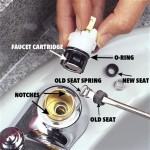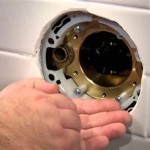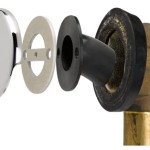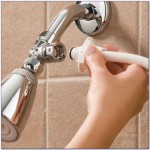Hair Filter For Bathtub Drain: Preventing Clogs and Maintaining Drainage
Bathtub drains are frequently susceptible to clogs, primarily due to the accumulation of hair. Effective hair filters for bathtub drains are essential for maintaining proper drainage and preventing costly plumbing repairs. These devices intercept hair and other debris before they enter the drainpipe, thereby reducing the likelihood of blockages. The selection, installation, and maintenance of hair filters each significantly contribute to overall effectiveness and longevity.
Various types of hair filters are available, each designed with different mechanisms and materials. The efficiency of a particular filter hinges on its design, the frequency of cleaning, and the volume of hair and debris it typically encounters. Understanding the different types of filters and their respective strengths and weaknesses can enable homeowners to make informed decisions about which option best suits their needs.
Types of Hair Filters for Bathtub Drains
Several designs of hair filters are available for bathtub drains, each offering different advantages and disadvantages. These include mesh filters, silicone stoppers with hair catchers, and drain screens. The suitability of a particular type often depends on the bathtub's drain configuration and individual preferences.
Mesh Filters: These filters typically consist of a fine mesh screen made of stainless steel or plastic. The mesh is designed to capture hair and other small particles while allowing water to pass through. Mesh filters are usually inserted directly into the drain opening. They are generally inexpensive and easy to install and remove for cleaning. However, they may require frequent cleaning, especially in households with multiple occupants or individuals with long hair. The fineness of the mesh impacts its ability to capture smaller debris, but a finer mesh can also reduce water flow if not cleaned regularly.
Silicone Stoppers with Hair Catchers: This type of filter incorporates a silicone stopper that seals the drain to prevent water from escaping, combined with a built-in hair-catching mechanism. These mechanisms often feature a basket or a series of holes designed to trap hair. Silicone stoppers offer the dual benefit of acting as a drain stopper and a hair filter. They are typically easy to install and clean. However, some models might not fit all drain sizes perfectly, potentially compromising their effectiveness as a stopper. The design of the hair-catching component can also influence how effectively it traps hair and how easily it can be cleaned.
Drain Screens: Drain screens are generally placed over the drain opening and held in place by their weight or suction. They are often made of metal or plastic and feature a perforated surface that allows water to pass through while blocking hair and debris. Drain screens are generally easy to install and remove. They can be a good option for bathtubs with drain openings that are not compatible with other types of filters. However, some drain screens may not be as effective at capturing fine hair compared to mesh filters. The design and material of the screen influence its durability and resistance to corrosion.
Installation of Hair Filters
The installation process for a hair filter is typically straightforward and requires minimal tools. However, adherence to specific instructions is crucial for ensuring proper fit and function. Improper installation can compromise the filter's effectiveness and potentially damage the drain.
Preparation: Before installing a hair filter, the bathtub drain should be thoroughly cleaned. Remove any existing hair or debris from the drain opening. This ensures that the filter can be properly seated and will not be obstructed by pre-existing blockages. Using a tool like a bent wire or a drain snake can help remove stubborn clumps of hair. Additionally, it is advisable to wear gloves during this process to protect hands from bacteria and grime.
Installation Process: The installation process varies depending on the type of filter. For mesh filters, the filter is simply inserted into the drain opening. Ensure that the filter sits flush with the drain and does not wobble or move. For silicone stoppers with hair catchers, the stopper is placed over the drain opening and pressed down to create a seal. Check the seal by filling the bathtub with a small amount of water to ensure that the stopper is effectively preventing water from leaking. For drain screens, the screen is placed over the drain opening, ensuring that it is securely positioned and does not easily move. Some drain screens may have suction cups to help them adhere to the bathtub surface.
Post-Installation Check: After installation, test the filter by running water into the bathtub. Observe the water flow to ensure that the filter is not significantly impeding drainage. Check for any leaks around the filter. If the water drains slowly or leaks are present, the filter may not be properly installed or may be the wrong size for the drain. Adjust the filter as needed to ensure proper fit and function. It may be necessary to try a different type of filter if the initial choice proves incompatible with the bathtub's drain configuration.
Maintenance and Cleaning of Hair Filters
Regular maintenance and cleaning are essential for ensuring the continued effectiveness of a hair filter. Accumulated hair and debris can reduce water flow and eventually lead to clogs. The frequency of cleaning depends on factors such as the number of occupants in the household, the length of their hair, and the frequency of bathtub use.
Cleaning Frequency: A general guideline is to clean the hair filter at least once a week. However, in households with heavy bathtub use or individuals with long hair, more frequent cleaning may be necessary. Regularly inspecting the filter will help determine the optimal cleaning schedule. Visible accumulations of hair and debris indicate that it is time to clean the filter.
Cleaning Process: The cleaning process is generally simple. For mesh filters, remove the filter from the drain opening and discard the accumulated hair and debris. Rinse the filter under running water to remove any remaining particles. For silicone stoppers with hair catchers, remove the stopper from the drain opening and detach the hair-catching component. Discard the accumulated hair and debris. Rinse both the stopper and the hair-catching component under running water. Use a brush or sponge to remove any stubborn residue. For drain screens, remove the screen from the drain opening and discard the accumulated hair and debris. Rinse the screen under running water to remove any remaining particles. A brush or sponge can be used to clean the screen more thoroughly.
Disinfection: Periodically disinfecting the hair filter can help prevent the growth of bacteria and mold. This is especially important in damp environments. The filter can be disinfected by soaking it in a solution of diluted bleach or vinegar. After soaking, rinse the filter thoroughly with water to remove any residue. Ensure that the filter is completely dry before reinstalling it. Alternatively, commercial disinfectants specifically designed for bathroom use can be used, following the manufacturer's instructions.
Addressing Clogs: Despite using a hair filter, clogs can still occur in the drainpipe. In such cases, a drain snake or plunger can be used to dislodge the blockage. Chemical drain cleaners should be used with caution, as they can damage the drainpipe and pose health risks. If the clog persists, it may be necessary to consult a professional plumber. Regular maintenance of the hair filter significantly reduces the likelihood of severe clogs requiring professional intervention.
The consistent use of a hair filter, paired with regular cleaning, contributes significantly to maintaining a properly functioning bathtub drain and minimizes the potential for disruptive and costly plumbing problems. By understanding the types of filters available, proper installation techniques, and necessary maintenance procedures, homeowners can proactively address a common household issue.

Danco Hair Catcher Bathroom Tub Strainer 10306 The Home Depot

Anti Clog Hair Filter For Bathroom Sink Silicone Floor Drain Plug Bathtub Shower Kitchen

Tubshroom 1 5 In 75 Bathtub Drain Protector Hair Catcher Tpr With Abs White Chrome And Stopper Plug Bundle Hdtsstp315 The Home Depot

Reviews For Tubshroom 1 5 In 75 Bathtub Drain Protector Hair Catcher Tpr With Abs White Chrome And Stopper Plug Bundle Pg The Home Depot

Fuygrcj 8pcs Stainless Steel Drain Hair Filter Mesh Tub Protector Anti Slip Sink Stopper Multipurpose Bathtub Trap Stop Strainer

Hair Stopper Shower Filter Bath Tub Drain Protector Sink Bathroom White Silicone

4 Pack Hair Catcher Shower Drain Bathtub Cover Sink Tub Stopper

Shower Base Drain Cover 2 Pack Silicone Hair Catcher With Suction Cup Durable Square For Floor Filter

Shower Base Drain Cover 2 Pack Silicone Hair Catcher With Suction Cup Durable Square For Floor Filter

Teesod 2 Pack Flower Shape Shower Drain Hair Filter Chain Hook Catcher Strainer Snare For Bathroom Kitchen Bathtub
Related Posts








